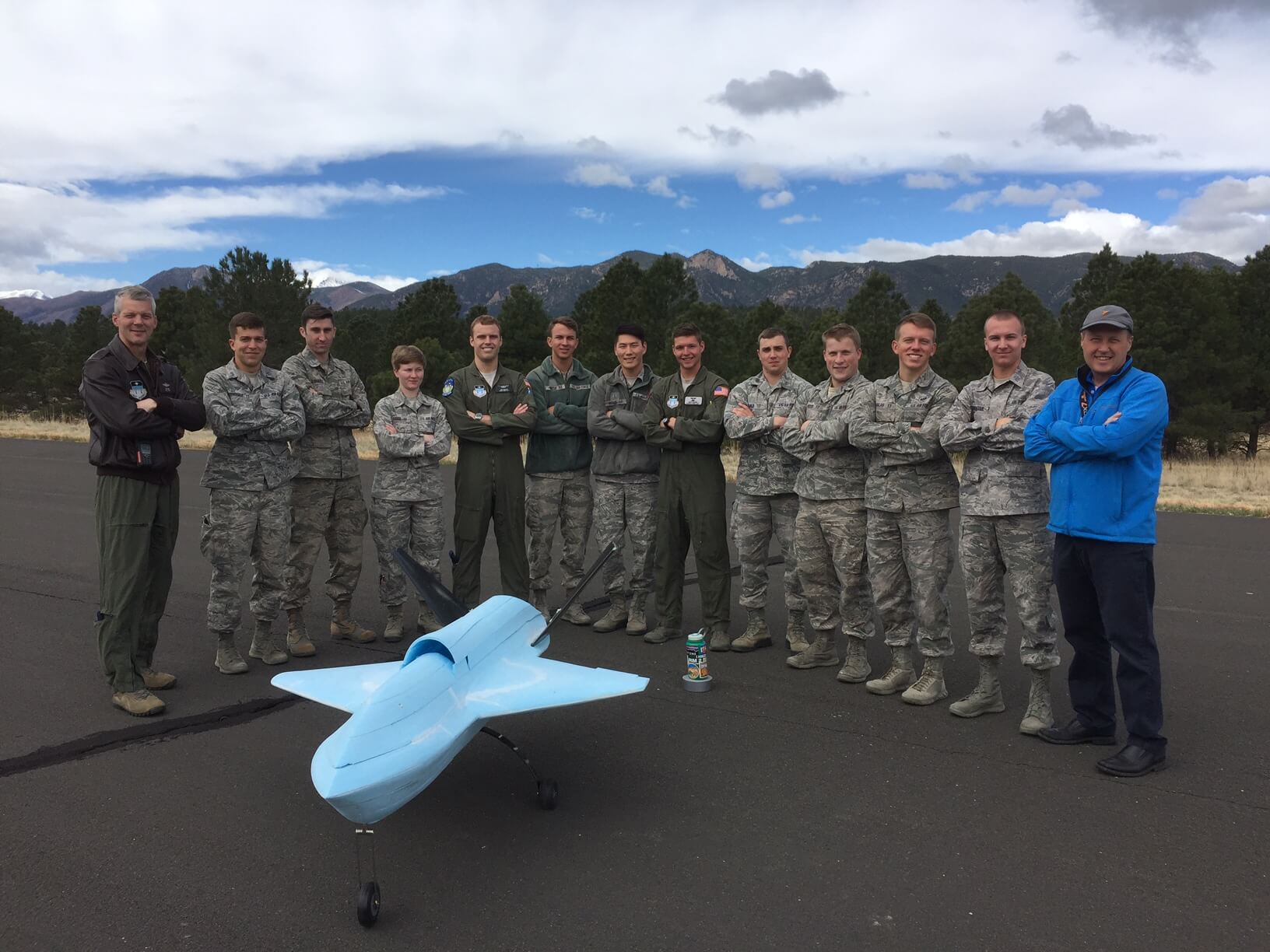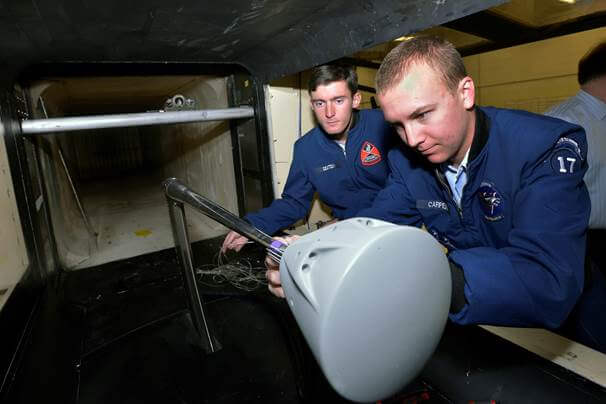How the Air Force Academy’s Aeronautics Department Innovates

(Col. John Cinnamon/U.S. Air Force photo)
Interview by Marsha Barancik, Oct. 30, 2017
U.S. AIR FORCE ACADEMY, Colo. — In the last decade, the Air Force Academy’s Aeronautics Department, with the support of the $125 million Aeronautics Research Center/Aeronautics Lab and the High Performance Computing Research Center, has transformed itself from a traditional academic program into a unique modeling center that accelerates the development of innovative aeronautics solutions for U.S. military and other federal agencies. Col John Cinnamon, Permanent Professor and Head of the Department of Aeronautics shares how it enables cadets to reinforce warfighter capabilities.
MB: How is the Aeronautical Lab still growing its capabilities?
Cinnamon: The threat to the warfighter is evolving quickly so we must evolve quickly too. Our high-impact process creates real solutions for real problems. Though we still analyze theoretical academic problems, we innovate in real-time, primarily with aircraft designed by cadets. We are always building new facilities and modernizing legacy systems. In the works is a Mach 6 wind tunnel, which could include a combustion shock tube. We have a world-class capability to take a cadet-generated idea and model it using high performance computers; build a model for testing in our wind tunnels; build a larger scaled version in UAV form; and fly it in the Academy’s unique airspace. This capability is one-of-a-kind and allows our students to design and test UAVs, which is not an option in most undergraduate institutions.
MB: How does the Aeronautical Lab win government projects?
Cinnamon: We win grants and projects because we produce quickly and at a relatively low cost. Like a company, we must maintain relationships with our clients – and stay on top of their needs. The research business is very competitive. We meet job requirements with simple, streamlined, but effective approaches. We often hear: “I can’t believe you did that for what we pay you.” We build low-cost aircraft constantly. We engineer at speeds and at prices that corporate test labs can’t compete with.

MB: Does theoretical work still have a role in the lab?
Cinnamon: We have eliminated some lecture material in lab classes to enable cadets to research and innovate more. Cadets now receive only seven or eight classroom lessons – and receive their problem project around lesson three and work on teams all semester to solve it. Team-based research is the best way to educate. Cadets might be working on different projects with unique approaches, but all are working to achieve our institutional and course outcomes.
MB: How do cadets/faculty integrate their R&D with the DoD Research Centers?
Cinnamon: Our efforts are driven by the needs of DoD research centers. We have worked long and hard to develop relationships with several directorates of the Air Force Research Laboratory, including Air Vehicles, Weapons, Lasers/Optics, and the AF Office of Scientific Research. We regularly interact with System Program Offices, such as the A-10, NASA, the US Army’s RDECOM, the U.S. Marine Corps and the Missile Defense Agency. Program reviews, professional conference interactions and direct visits keep us in tune with their research needs. Cadets directly affect warfighting capabilities. Full-time researchers, test pilots and technicians help full-time faculty members intensely mentor cadets.
MB: What are some recent breakthroughs built on years of lab research?
Cinnamon: For the Air Force Office and Scientific Research (AFOSR) and NATO, we are developing an aircraft that can be controlled without ailerons, rudders or elevators – relying on blowing turbojet-supplied air to ports on the aircraft’s surface. The blowing jets interact with the body and airflow to produce roll, yaw and pitch – improving aircraft stealth and performance. Its first flight is planned for 2018. Years of basic research in aerodynamic flow control and wind tunnel testing enabled the design.
Also, within one academic year, cadets now design, build and fly prototype UAVs with these innovative design features. We streamlined development and approvals, while having a flight success rate of over 80%. The UAVs are extremely inexpensive to develop, so we can experiment more broadly – and ultimately get concepts into the field faster.
Since 2014, cadets have been developing Sensing Unguided Recon Gliders (SURG). Roughly 200 book-size cardboard UAVs with sensors are launched into a chemical or munition plume to generate a real-time 3-D map of chemical concentrations. This project is sponsored by the 711th Human Performance Wing and the Air Force Surgeon General School Aeromedical Research Department.
To learn more about our work, visit the Aeronautical Lab.

MB: How do cadets need to think and operate differently to meet fast-changing DoD demands?
Cinnamon: We are embracing additive manufacturing (3D modeling and printing) to test ideas over a few days versus weeks or months. We’ve used this approach to rapidly build and test wind tunnel models, plus help customers develop field-manufacturable aircraft. Soon, field units can quickly assemble these aircraft and fly reconnaissance missions shortly after deployment without a long logistics tail. In developing quiet propellers, additive manufacturing enables us to conceive an idea in the morning, build it in the afternoon, and test it in the wind tunnel the next day. In the battlefield of the future, officers will not know what they must know. They will have to adapt quickly to changing situations and make decisions with limited information. Constant intellectual curiosity, critical thinking and adaptability are essential.
Research is the best way to develop critical thinking skills. We don’t know the right answers to the problems we give cadets. We rely on their out-of-the box thinking and peer reviews. And I’m confident that if the same project went to a company relying on standard R&D formulas, it would have limited scope and less creativity.
That we make cadets responsible for managing and completing challenging technical projects, then clearly reporting their results, nurtures the skills and mindsets needed in tomorrow’s Air Force.
MB: Which elements from your career progression have aided you in leading the Department of Aeronautics?
Cinnamon: I was fortunate to have a dual career, focused both on being an operational pilot and an engineer. I have been able to leverage the academic foundations formed here as a cadet, graduate school work, a tour teaching on the faculty as a Captain, 4600+ hours of flying time primarily in C-5s, T-38s, and T-1s, and a staff tour doing innovative engineering work to support the amazing professionals in the Department of Aeronautics educate cadets. They are the reason for the department’s success. It is my true honor to serve with them.
